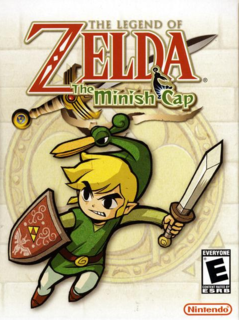Shrink, Link! Shrink!
The new aspect of play that Minish Cap unveils is the ability to allow Link to shrink. As the story goes, Zelda has been kidnapped (surprised?), and Link must go rescue her and save the kingdom while he's at it. Along the way, Link gets the help of Ezlo, an eccentric magician-turned-talking-hat. With Ezlo's help, you can become one of the Minish, who are small people that live out of sight of human beings. The plot is fairly weak, but the ability to shrink is pretty fun, and that ability is incorporated well throughout the entire game. Whether you're solving a puzzle, defeating enemies, or just helping townspeople out, the ability to shrink to microscopic proportions plays an important part.
Minish Cap offers new game play to Zelda fans, but it also sticks to the franchise's time-tested core gaming system. If you've ever played a 2D Zelda game before, then you have a good idea of how Minish Cap plays out. Controls are simple and easy to get the hang of. The B button controls your sword, and the A button is equipped with various items you find throughout the game.
Items in Minish Cap play a huge role. In each dungeon you visit, you'll find one or two new items. There's quite a mix of items and weapons throughout the game. Some, like the slingshot and bow, will be recognized by long-time Zelda fans. Other items, like the Cane of Pacci, are completely new. Regardless of whether they've been in past games, all the items that you find in Minish Cap are essential to your success in the game. All the items are incorporated into the dungeon design in some fairly mundane ways. While it's nothing from the norm, it will certainly keep you thinking. The use of items in boss fights, however, is far more interesting and enjoyable.
Taking on the final baddie of a dungeon or temple has always been epic in Zelda games, and it remain great in Minish Cap. Bosses are huge in proportion to the rest of the game, and you'll usually be faced with a real challenge when you're fighting a boss. In typical Zelda fashion, you need to hit the boss three times to defeat him, but it's never just as simple as that. The items that you've collected in that dungeon will always play a key role in the boss fight. Additionally, the boss fights bring out the best graphical quality present in Minish Cap.
Visually, Minish Cap exceeds all expectations I had going into the game. The graphics are colorful and cheery for the most part, and wonderfully complement the overall feel of the game. Enemies are also shown in vibrant color, which makes the game all the more immersive and enjoyable. The environmental graphics are also gorgeous. They're saturated with beautiful color and vibrancy, and makes the game so much more believable.
The music in Zelda games has always been fantastic, and its also decent in Minish Cap. It certainly helps the overall atmosphere of the game and it's fun to listen to, but it's also all too forgettable. As in most other Zelda games, each dungeon has a different song that matches the theme of that dungeon. The music is a subtle aspect of the game, but it does help Minish Cap to be a more enjoyable gaming experience.
Minish Cap offers a very fun gaming experience, but it won't last very long at all. The game clocks in at only about 20 hours, and it's incredibly easy. Past Zelda games have been targeted at hardcore fans of the franchise, but it's clear that Minish Cap was intended for newcomers. Puzzles have a presence, but are almost laughable; it takes next- to-no brainpower to solve them. Also, the amount of enemies that you'll encounter throughout the game contributes to the fact that Minish Cap is so darn easy. Forget about Link-to-the-Past-style-enemies, where you'll suddenly walk into a room with hordes of bad guys. Instead, Minish Cap chooses to take the fighting- and thinking-difficulty out of the game. It causes very smooth, unsatisfying play throughout the entire game.
Additionally, once you beat Minish Cap, there's not much of a reason to keep on playing. There's no bonus you get for beating everything again, and the game is so easy that it's honestly not worth playing through a second time. There is, however, one reason that you may continue to play: Kinstones. Throughout Hyrule, there are mysterious objects called Kinstones pieces. They vary in color and shape, but it's possible to fit together two matching pieces to form a complete Kinstone. Not only does collecting and matching Kinstones open up favorable events in the game, but it's also mildly challenging and very addicting.
While there is certainly room for improvement, Minish Cap is still a solid entry in the Zelda franchise. It combines solid Zelda-style game play with some new twists to create an enjoyable game. The music and graphics further the quality of Minish Cap even more, and create Hyrule all over again. Unfortunately, a pathetic difficulty level and less-than-average gaming time holds Minish Cap from being the best it could truly be.

